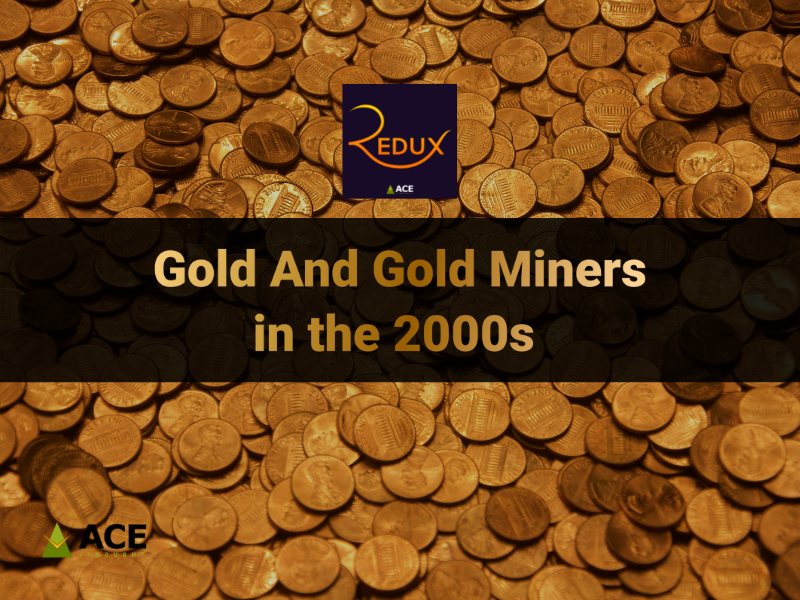
Here is the transcript if you would like to read instead:
Harshil:
As the ultimate store of value gold has performed well during the past 15 months, hitting a new high of nearly 2000$/oz.
On this episode I sit down with the founder and ideator of ithought, Shyam Sekhar. Shyam is a market veteran having 3 decades of experience. A contrarian by nature, his expertise includes spotting opportunities early on and strategizing investment themes. Shyam can you take us through how gold and gold miners played out in the 2000s.
Lets’ talk about how the cycle played out for gold and gold miners since 2000.
Shyam Sekhar:
The gold industry had experienced a roller-coaster ride, with prices rising from USD 255/oz in 2001 to highs of USD 1,906/oz a decade later, before falling to USD 1,056/oz by December 2015. This was when NASDAQ lost approximately 80% of its value between 2000-2002, dropping from 5,047 to 1,114 and, in the process, representing a USD 5 trillion to 7 trillion loss in value. The end of the dot-com bubble and subsequent events were the catalyst for the decade-long rally in gold prices. This price increase led to a massive debt fueled and an acquisition driven expansion undertaken by the miners.
Harshil:
How aggressive of an expansion are we talking about?
Shyam Sekhar:
Beyond my level of comfort! *Insert laugh* You have to understand people were predicting gold prices to rise above USD 5,000/oz back then. This was the base upon which capital for new projects were being put up. From 2000 to 2010, the industry saw over 1,000 acquisitions with a combined value of USD 121 billion, compared to only USD 27 billion from 1990 to 2000; nearly 4.5 times and the industry was paying a premium of 30-40%. It does not end at that. At the peak in 2011 there were over USD 38 billion in acquisitions- in one year alone! All of this collapsed when gold fell from USD 1,906/oz to USD 1,056/oz between September 2011 and December 2015 which forced companies to cut costs aggressively.
Harshil:
Right, so from there on the focus was- cutting costs, cutting down on CAPEX and deleveraging balance sheet. How did they go about doing that?
Shyam Sekhar:
In my experience when companies pay a high premium it ends up hitting their balance sheet. (Asset impairment). This sort of course correction reflects in the ROEs of the industry which were low around 2% during 2010-16. By the end of 2015 gold started going up, dollar had strengthened, and oil was getting weaker. This combination of strong dollar, low oil prices and increasing gold price actually helped their costs cutting program which in turn reduced their debt and resulted in a much stronger balance sheet.
Harshil:
But the success of every miner lies in exploration and building up their reserves…
Shyam Sekhar:
Yes, unless companies discover, build, or buy new mines, they will eventually deplete themselves out of business. Gold miners have a longer lead time, meaning that it takes 10-15 odd years for a mine to go from feasibility study to commercial production due to various factors and the effect of reduced spends meant that mining companies were barely able to replace what they sold while converting nearby resources to reserves.
Matlab Jo Haat Mein Hai, Woh Hi Hai!
Harshil:
It has been 2 years since the pandemic, we have seen a huge commodity rally globally, what do you think about gold and gold miners now.
Shyam Sekhar:
After a decade of declining cash reserves, gold producers are flush with cash today, the highest since 2007 and as long as the price of gold continues to be strong, miners will continue to stay strong. The pandemic is not over, the fed is still purchasing assets. We had seen this before during 2006-2011 when gold when up 120% compared to equity markets where investors wanted to protect themselves against the erosion of purchasing power. Once quantitative easing kicks in the strength of dollar is always tested. It is going to be difficult for the central banks to come out of this pandemic. As long the supply of money is increasing, and interest rates remain low, holding gold is wise.
*Investing experience in gold during the last boom*
Harshil:
Before I let you go, I just want to talk about how central banks use gold in stabilising their balance sheets.
Shyam Sekhar:
Most central banks hold the majority of their foreign exchange reserves in USD, and this exposes them to any volatility in the US currency, especially during times of uncertainty. We are in a time of uncertainty and people have forgotten that. Central banks collectively own more than 35,000 tonnes of gold which is around 17% of known gold that is out there. This makes it the third-largest reserve asset in the world. And what they do is that they include gold as part of their foreign currency revaluation reserves. Simply put when USD falls gold gets revalued on the books. This counter-cyclical nature of gold is the benefit that central banks get as a natural hedge to currency.
Harshil:
Thank you so much for coming on the show and sharing your insights.
Shyam Sekhar:
My pleasure!
Harshil:
Alright guys that’s all we have for this week if you are loving this show go ahead and follow us on your favorite podcast app to get updates on our new episodes and with that, we will see you again next time.